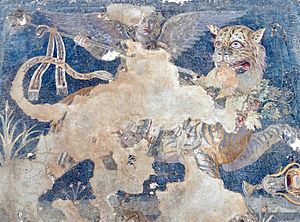Dionysia facts for kids
The Dionysia (Greek: Διονύσια) was a big festival in ancient Athens. It honored the god Dionysus, who was linked to wine, theater, and celebration. The main events of the festival were plays, including serious tragedies and, later, funny comedies. This festival was the second most important in Athens, after the Panathenaia. The Dionysia actually included two related festivals: the Rural Dionysia and the City Dionysia. They happened at different times of the year.
Contents
Rural Dionysia
The Rural Dionysia was an older festival. It took place in the countryside, in a place called Eleutherae in Attica. It probably celebrated the growing of vines and the harvest. This festival was likely very old, perhaps even before it was connected to Dionysus.
Because different towns in Attica held their festivals on different days, people could visit more than one. This also allowed groups of actors to perform in many towns during the festival season. The famous funny playwright Aristophanes even made fun of the Rural Dionysia in his play The Acharnians.
City Dionysia
How the City Dionysia Started
The City Dionysia, also known as the Great Dionysia, was the city part of the festival. It might have started around the 6th century BC, during the time of Peisistratus, a ruler of Athens. This festival was held about three months after the Rural Dionysia, usually in March or April. It probably celebrated the end of winter and the harvesting of crops.
A story says the festival began after Eleutherae, a town near Attica, joined Athens. The people of Eleutherae brought a statue of Dionysus to Athens. At first, the Athenians did not accept it. So, Dionysus punished them with a sickness. The sickness went away when the Athenians finally accepted the god's worship. To remember this, each year, citizens would march in a procession carrying special symbols.
Processions and Pre-Contest Events
The leader of Athens, called the archon, started preparing for the City Dionysia as soon as he was chosen. He picked helpers to organize everything. On the first day of the festival, a big procession called the pompē took place. Citizens, foreigners living in Athens, and people from Athenian colonies marched to the Theatre of Dionysus. They carried a wooden statue of Dionysus.
During the time when Athens was very powerful, people also carried gifts and items that showed Athens' strength. Bulls were also part of the procession, to be sacrificed later. The most noticeable people in the procession were the chorēgoí, who were rich citizens who paid for the festival's events. They wore very fancy clothes. After the pompē, the chorēgoí led their singing groups in competitions. These were very competitive, with famous musicians and poets taking part. After these contests, the bulls were sacrificed, and everyone in Athens enjoyed a big feast. Another lively celebration, called the kōmos, happened afterwards in the streets.
The next day was called the proagōn, or "pre-contest." During this event, playwrights announced the names of the plays that would be performed. Judges were also chosen by drawing lots. The proagōn was also a time to honor important citizens or foreigners who had helped Athens. Sometimes, it was used to make other announcements, like when the death of the famous playwright Euripides was announced in 406 BC.
Dramatic Performances
After the pompē, the Theatre of Dionysus was cleaned with a bull sacrifice. The first tragedy play at the Dionysia is said to have been performed by Thespis in 534 BC. He was an actor, and that's where we get the word "thespian" (meaning actor). His prize was reportedly a goat, which was a symbol for Dionysus. This might be why the word "tragedy" means "goat-song."
In the 5th century BC, five days of the festival were set aside for plays. At least three full days were for tragic plays. Each of three playwrights would present a set of three tragedies and one satyr play (a funny play with mythical creatures). Many of the Greek tragedies we still read today, by writers like Aeschylus, Euripides, and Sophocles, were first performed at the Theatre of Dionysus. The leaders and judges watched from the very front row.
The other two days of the festival likely had singing contests until 487/6 BC. After that, funny plays (comedies) were officially added, and comic poets could win prizes. Each of five comic writers presented one play. It was a great honor to win the comedy prize at the City Dionysia, even though comedies were sometimes seen as less important than tragedies.
Even after the 4th century BC, new tragedies continued to be written and performed. Plays from earlier times, especially those by Euripides, were often performed again. Some people think audiences preferred to see well-known plays again, or perhaps it was a way to remember the glory of Athens before the difficult Peloponnesian War. Plays continued to be produced until the 2nd century BC. After that, prizes were given to the wealthy people who paid for the plays and to famous actors, rather than to the playwrights themselves.
On the last day of the festival, there was another procession and celebration. The judges announced the winners of the tragedy and comedy performances. The winning playwrights received a wreath made of ivy.
See also
 In Spanish: Dionisias para niños
In Spanish: Dionisias para niños
- Athenian festivals
- Anthesteria
- Bacchanalia
- Ganachakra
- Lenaia
- Panathenaia


